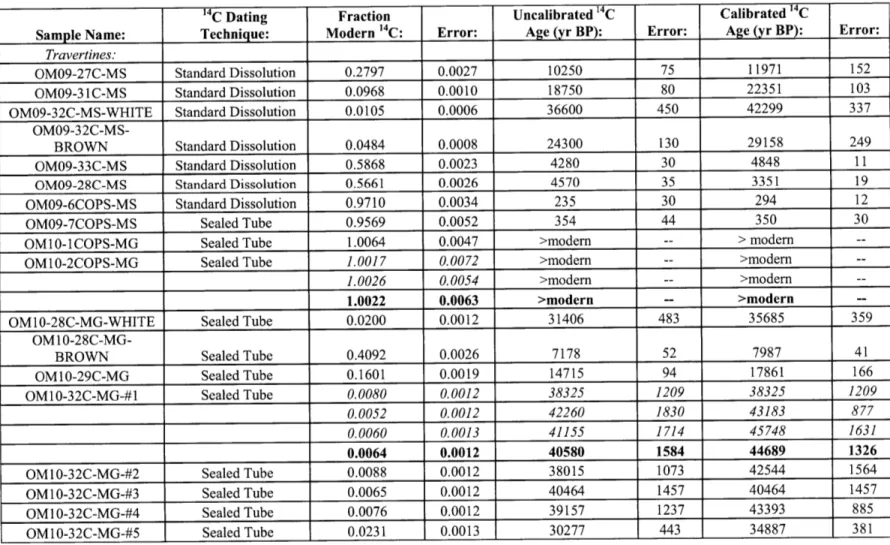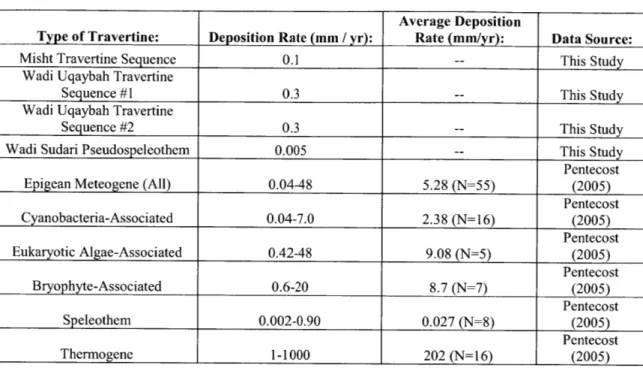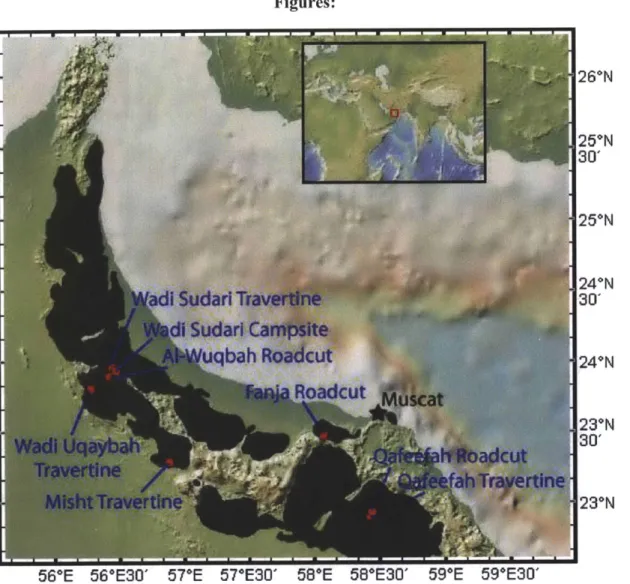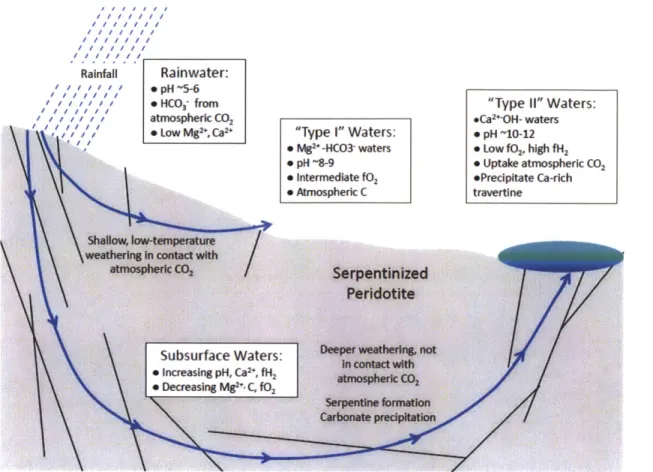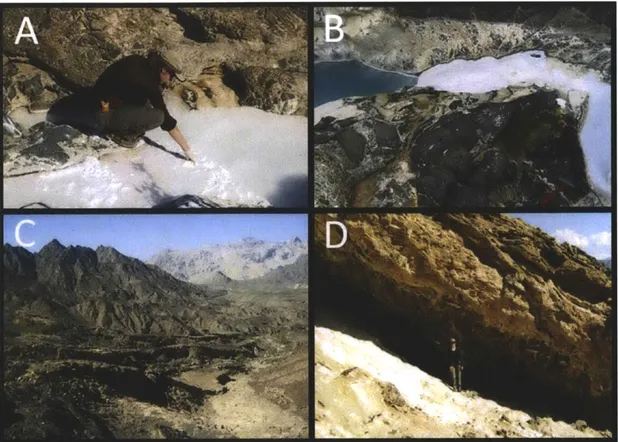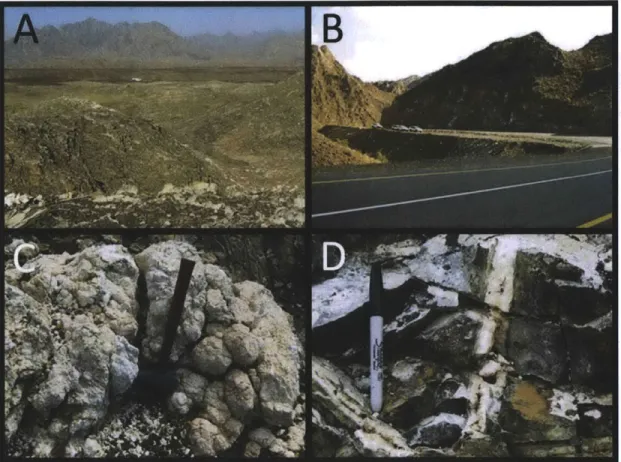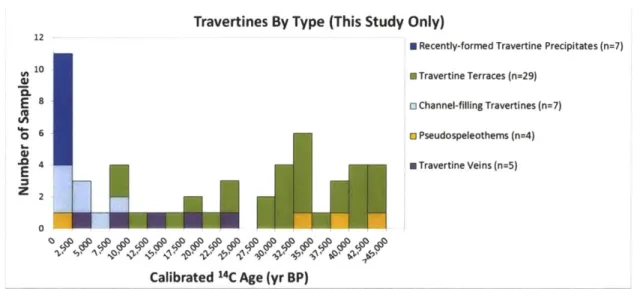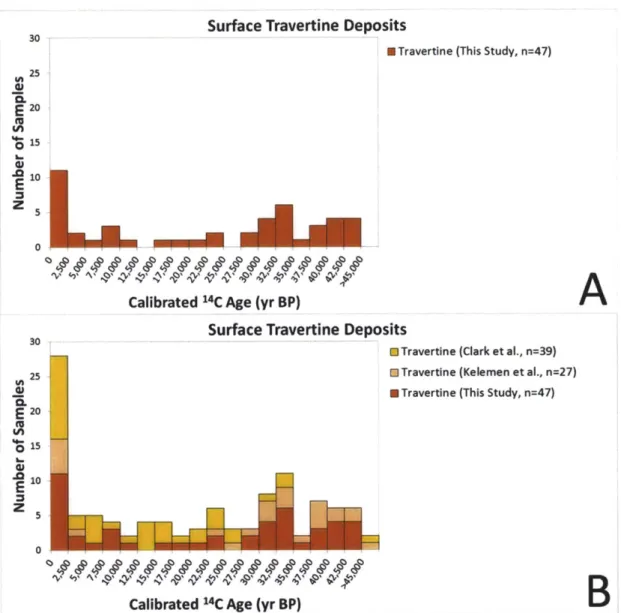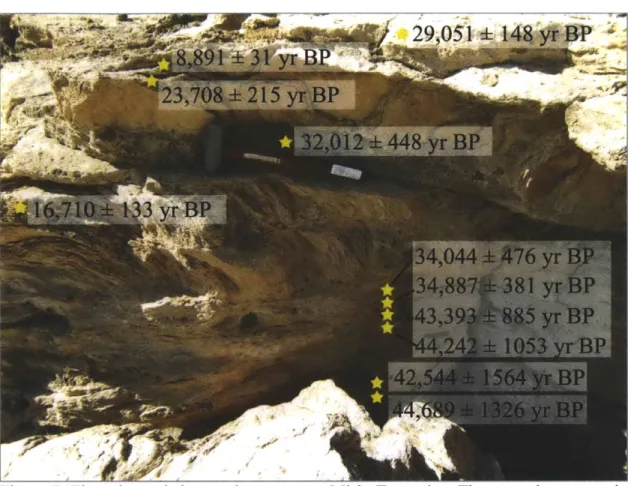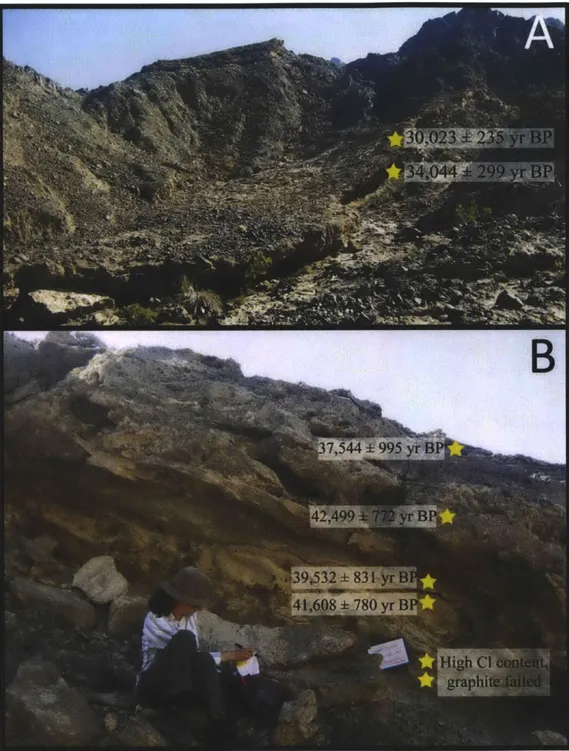DETERMINING TIMESCALES OF NATURAL CARBONATION OF
PERIDOTITE IN THE SAMAIL OPHIOLITE, SULTANATE OF OMAN
By
Evelyn Martinique Mervine
B.A. Earth Science and Arabic Language & Literature, Dartmouth College, 2006
Submitted in partial fulfillment of the requirements for the degree of
Doctor of Philosophy
ARCIV
O
at the
MASSACHUSETTS INSTITUTE OF TECHNOLOGY
and the
WOODS HOLE OCEANOGRAPHIC INSTITUTION
June 2012
V 2012 Evelyn Martinique Mervine
All rights reserved.
The author herby grants to MIT and WHOI permission to reproduce and to distribute
publicly paper and electronic copies of this thesis document in whole or in any part in any
medium now known or hereafter created.
Signature of Author
Joint Program in Mine Geology aid Geophysics
Massachusetts Institute of Technology
and Woods Hole Oceanographic Institution
May 4th, 2012
Certified by
Dr. Susan .Himphl,
Thesis Suyrvi
Dr. KeneffIW. W. Sims, Thesis Supervisor
Accepted by
Dr. Robert L. Evans
Chair, Joint Committee for Marine Geology and Geophysics
Massachusetts Institute of Technology/
Determining Timescales of Natural Carbonation of Peridotite in the Samail Ophiolite, Sultanate of Oman
By
Evelyn Martinique Mervine
Submitted to the Joint Committee for Marine Geology and Geophysics on May 4th, 2012 in partial fulfillment of the requirements for the degree of Doctor of Philosophy
Abstract:
Determining timescales of the formation and preservation of carbonate alteration products in mantle peridotite is important in order to better understand the role of this potentially important sink in the global carbon cycle and also to evaluate the feasibility of using artificially-enhanced, in situ formation of carbonates in peridotite to mitigate the buildup of anthropogenic CO2 emissions in the atmosphere. Timescales of natural carbonation of peridotite were investigated in the mantle layer of the Samail Ophiolite, Sultanate of Oman. Rates of ongoing, low-temperature CO2 uptake were estimated
through 14C and 2 30Th dating of carbonate alteration products. Approximately 1-3 x 106 kg C0 2/yr is sequestered in Ca-rich surface travertines and approximately 107 kg C0 2/yr
is sequestered in Mg-rich carbonate veins. Rates of CO2 removal were estimated through
calculation of maximum erosion rates from cosmogenic 3He measurements in partially-serpentinized peridotite bedrock associated with carbonate alteration products. Maximum erosion rates for serpentinized peridotite bedrock are -5 to 180 m/Myr (average: -40 m/Myr), which removes at most 105-106 kg CO2/yr through erosion of Mg-rich carbonate
Dedication
I would like to dedicate my thesis to James "The Amazing" Randi, who taught me to
think critically about the world around me and who reminds me that a PhD only means
Acknowledgments:
First and foremost, I give my deepest thanks to my WHOI advisor Susan Humphris. Susan was an excellent mentor and role model, and she supported me through many difficult time periods and transitions during the course of my PhD journey. In the midst of an incredibly busy schedule, Susan always made time for me. Time and again, she went above and beyond the normal obligations of a PhD advisor. She even flew all the way to Muscat, Oman for three days to help me prepare for a conference presentation. Susan always pushed me to do my very best work, and she made sure that I had the support and resources that I needed in order to do my best work. I have no doubt that without Susan's mentorship I would not be here today, submitting my PhD thesis.
Susan's support over the years has been invaluable.
I also owe sincere thanks to my co-advisor Ken Sims. When I decided to leave my
first PhD project, Ken immediately offered to take me on as a student. When I asked if it would be possible for me to work in the Samail Ophiolite, Ken helped me develop a collaboration with Peter Kelemen and wrote grants to support the new research project. Even after Ken moved from WHOI to the University of Wyoming, he continued to support my work and even brought me out to Laramie for a summer. Ken flew back to WHOI numerous times to help me finish my PhD, and he endured many long Skype calls of my questions.
I also owe thanks to my PhD committee members, particularly Peter Kelemen.
Peter was excited and supportive when I expressed my desire to work in the Samail Ophiolite, and he helped me develop the research that now comprises my PhD thesis. Sam Bowring provided much sage advice about geochronology, graduate school, and life in general. Dan McCorkle helped me navigate my advisor transitions and also provided valuable scientific input and constructive criticism. Bill Jenkins was a source of expert
14
C advice and he also challenged me to think about the broader implications of my thesis
research. Finally, I owe thanks to my committee chair Bernhard Peucker-Ehrenbrink, who ensured that my thesis defense was well-organized and went smoothly.
I would also like to thank my original advisor Fred Frey. Although I decided not
to continue the Ninetyeast Ridge research project for my PhD, Fred brought me to MIT and supported me for two years. During the time I worked with Fred, I learned a great amount about geochemistry and geochronology. I am grateful that Fred passed on to me a small fraction of his extensive knowledge. I also very much enjoyed participating in a two month expedition in 2007 to the Ninetyeast Ridge. I met good friends and colleagues- and also my now-husband- on the expedition, and it was an experience of a lifetime.
In addition to my advisors and committee members, I have many scientific collaborators and supporters to thank. Ann McNichol, Mark Roberts, Al Gagnon, and the rest of the NOSAMS staff are thanked for welcoming me into the laboratory and teaching me about 14C dating. I am grateful to Chris Weidman for allowing me to subsample my
carbonates using his microsampler. Margaret Sulanowska helped with sample preparation and XRD analysis. Lora Wingate provided the stable isotope analyses in a quick and professional manner. Chris Waters and Lynne Elkins, who were my fellow students under
Ken, taught me about uranium-series geochemistry, both in the lab and outside of the lab.
Mark Kurz and Josh Curtice provided mentorship and laboratory assistance for the
cosmogenic
3Hemeasurements. I also owe thanks to Steve Richardson, who graciously
provided me with peridotite thin sections free of charge, Henry Dick, who provided me
with important information about the petrology and alteration of peridotites, and Frieder
Klein, who shared his knowledge about carbonation of peridotite. Vera Pavel and Claire
Pontbriand provided assistance with MATLAB programming. I also owe special thanks
to Jurek Blusztajn, who was a constant source of support in the geochemistry and mass
spectrometry labs. I especially appreciate Jurek's cheerful nature and infectious
optimism, which were helpful when I was analyzing my most challenging samples.
I also owe thanks to many people for support, scientific discussions, and
adventures in the field in Oman. Peter Kelemen's field experience was highly valuable. I
also wish to give thanks to Ali Al-Rajhi, Ministry of Commerce and Industry, Sultanate
of Oman, and Sobhi Nasir, Sultan Qaboos University, for logistical support during field
seasons. Ken Sims, Jirg Matter, Everett Shock, Lisa Streit, Amelia Paukert, and other
members of the field team are also thanked. I especially want to thank my husband Ernest
(Jackie) Gauntlett, who took three and a half weeks of vacation time to be my field
assistant during the 2010 season.
I am very grateful to have been part of the MIT/WHOI Joint Program, which
provided me with wonderful opportunities and support. I wish to thank Jim Yoder, Meg
Tivey, Julia Westwater, Marsha Gomes, Tricia Gebbie, and other members of the
Academic Programs Office for their support. I particularly enjoyed the Geodynamics
Program, which gave me the opportunity to participate in geology field trips to Costa
Rica, Barbados, Switzerland, and Italy. These trips provided a welcome break from
labwork and helped remind me why I love geology so much.
My friends and fellow classmates in the Joint Program were also incredibly
supportive. We helped each other survive graduate school-and we often had good fun
along the way. In particular, I wish to thank Vera Pavel, Jimmy Elsenbeck, Claire & Cliff
Pontbriand, Arthur Olive, Michael Holcomb, Emily & Casey Saenger, Alison
Criscitiello, Lynne Elkins, Chris Waters, Matt Jackson, Maya Bhatia, Andrea Burke,
Helen Feng, Li Ling Hamady, Elise Olson, Meredith White, Dan Ohnemus, Karin
Lemkau, Camilo Ponton, Min Xu, Fern Gibbons, Holly Owens, Christy Till, Jay Barr,
and Mike Krawczynski. I also wish to thank my friends outside of graduate school,
particularly my friends in South Africa. John, Joy, Davor, Cathy, Nia, Patrick, Kaylee,
Nick, Greg, Andrea, Vere, Marius, and Helen-thank you for making me feel at home in
South Africa and for sometimes fetching books for me from the University of Cape Town
library.
Since November 2010 I have written a geology blog and been involved with the
geoblogosphere, an online community of amateur and professional geologists. I wish to
thank the American Geophysical Union for hosting my blog and the entire
geoblogosphere for support, advice, and fun discussions. In particular, I'd like to thank
geobloggers Dana Hunter, Callan Bentley, Jessica Ball, Anne Jefferson, Chris Rowan,
Erik Klemetti, Brian Romans, Lockwood DeWitt, Ron Schott, and Ryan Brown.
Finally, I owe great thanks to my family, particularly my parents Mark and Barbara and my sister Aynsley. My parents ensured that I received an excellent education starting from a young age, and they were an incredible source of strength during my PhD. Randi, my adopted grandfather, and his partner Jose have also been a strong source of encouragement and support. Words cannot express my gratitude to my husband Jackie, who supported me during the best and the worst of graduate school. Long distance relationships are difficult, particularly when they stretch from Cape Cod to Cape Town. Jackie was incredibly supportive of my PhD-in person or, more often, over Skype-during five years of long distance. He patiently endured my moments of despair and refused to let me quit, even when I was convinced that there was no way I could continue. Jackie also supported my PhD by cooking me many delicious dinners, figuring out how to move my books (and cats) to South Africa during my last year of graduate school, and chatting with me about geology during hikes and over countless cups of rooibos tea.
My PhD thesis research was funded by the National Science Foundation grant
EAR- 1049281, the Deep Ocean Exploration Institute at WHOI, the Academic Programs Office at WHOI, and the Mellon Foundation.
Table of Contents:
1.
Introduction...11
1. Natural Carbonation of Peridotite...15
2. Mineral Sequestration of CO
2...
.. . . .. . . .. . . ..17
3. Structure of the Thesis...19
2.
1CDating of Carbonate Alteration Products of Peridotite in the Samail
Ophiolite, Sultanate of Oman...28
1. Introduction ...
29
2. G eologic Setting...
31
2.1
Geology of the Samail Ophiolite...31
2.2 Carbonate Alteration Products Formed in the
Sam ail O phiolite...
32
3. Sample Descriptions...36
4. M ethods...
. .. 38
5 . R esu lts...4
1
5.1
M ineralogy...
4 1
5.1.1
Travertines...
42
5.1.2 Mg-Rich Carbonate Veins...43
5.2 Distribution of
14C Ages...43
5.2.1
Travertines...
44
5.2.2 Mg-Rich Carbonate Veins...49
5.3
Stable Isotope Analyses...50
6. D iscussion ...
. 51
6.1 Temporal and Spatial Trends in Carbonate Formation...51
6.1.1
Surface Travertine Deposition and Preservation...51
6.1.2
Mg-Rich Carbonate Veins...53
6.1.3
Isotopic V ariability...56
6.2 Carbonate Formation Temperatures...57
6.3 Estimating Natural Rates of Carbonate Formation in the Peridotite Layer
of the Samail Ophiolite...59
6.3.1
Travertine Deposition Rates...59
6.3.2 Natural CO
2Sequestration in Mg-Rich Carbonate Veins...61
7. Sum m ary...
62
8. Acknowledgments...64
3.
230 ThDating of Carbonate Alteration Products of Peridotite in the Samail
Ophiolite, Sultanate of Oman: Applications and Limitations...111
1. Introdu ction ...
112
2. G eologic Setting...113
3. Sam ple D escriptions...114
4 . M eth o d s...1
16
5. Results ... 119
5.1 Mineralogy... 119
5.2 U and Th Concentrations...120
5.2 U and Th Isotopes...122
6 . D iscu ssion ... 124
6.1 Systematics of U and Th in Samail Carbonates, Peridotites, and S ed im en ts...124
6.1.1 Systematics of U and Th Concentrations...124
6.1.2 Systematics of U and Th Isotopes...127
6.2 Approaches and Limitations for Determining 2 30Th Ages for Samail C arb on ates...130
6.2.1 2 3 0Th Dating of Terrestrial Carbonates...130
6.2.2 2 30 Th Dating of Travertines...136
6.2.3 230T Dating of Mg-Rich Carbonate Veins...138
6.3 Implications for Natural Rates of Carbonate Formation in the Peridotite Layer of the Samail Ophiolite...140
7 . Su m m ary ... 142
8. A cknow ledgm ents...143
4. 3He Exposure Ages and Erosion Rates of Serpentinized Peridotite Bedrock, Samail Ophiolite, Sultanate of Oman...175
1. In trodu ction ... 175
2. Geologic Setting... 179
3. Sam ple D escriptions...180
4. Methods...184
4.1 Sam ple Preparation...184
4.2 Helium Measurements...184
5. R esults and D iscussion...185
5.1 M ineralogy ... 185
5.2 Helium Measurements...186
5.2.1 4H e C oncentrations...186
5.2.2 H e Isotopes...187
5.3 Radiogenic Production of 4He from U and Th Decay...190
5.4 Exposure Ages from Cosmogenic 3He...192
5.5 Erosion Rates from Cosmogenic 3He...194
5.6 Implications for Erosion of the Peridotite Layer of the Samail Ophiolite ... 195
5.6.1 Ultramafic Erosion Rates...195
5.6.2 Implications for Natural CO2 Sequestration in the Samail O ph iolite...196
6. Sum m ary... 197
5. Synthesis and Future Directions...225
1. Travertine D eposition...226
2. Formation of Mg-Rich Carbonate Veins...229
3. Beyond the Samail Ophiolite...231
Appendix A: Carbonate Dissolution Experiments for U and Th Analyses...239
Appendix B: Additional Sensitivity Analysis Figures for Initial
230Th Corrections of
2 30Th Ages for Samail Carbonates...258
Chapter 1: Introduction
Alteration of ultramafic rocks such as peridotite is a poorly constrained category of silicate weathering. Although silicate weathering is well-established as a significant
sink for carbon (e.g. Ebelmen, 1845; Rubey, 1951; Walker et al., 1981; Raymo and
Ruddiman, 1992; Berner and Berner, 1997; Gaillard et et al., 1999; Berner and
Kothavala, 2001; Dessert et al., 2003; Gislason et al., 2006; Kashiwagi et al., 2008;
Gislason and Oelkers, 2011), one of the greatest sources of uncertainty in the carbon cycle is the amount of carbon stored in silicate rocks, including mafic and ultramafic
lithologies (e.g. Holser et al., 1988; Sundquist, 1993; Gislason and Oelkers, 2011). While
carbonation of mafic and ultramafic rocks is commonly observed, the amount of carbon stored globally in these carbonate alteration products has not been adequately quantified. Constraining rates of mafic and ultramafic weathering and carbonation is essential in order to fully understand and balance the global carbon cycle and also to evaluate the viability of using artificially-enhanced weathering of mafic and ultramafic rocks to mitigate the buildup of anthropogenic CO2 input to the atmosphere (e.g. Seiftritz, 1990; Lackner et al., 1995; Lackner, 2002; Kelemen and Matter, 2008; Matter and Kelemen, 2009; Gislason et al., 2010; Kelemen et al., 2011).
A few studies have attempted to quantify the amount of carbon stored in mafic
(2003) estimated that chemical weathering of basalts consumes 1.8 x 10" kg C02/yr'.
This result is significant because although basalt represents only ~5% of the continental surface, basalt weathering constitutes ~30-35% of the ~5.15 x 1011 kg C0 2/yr consumed
by continental silicate weathering (Gaillardet et al., 1999; Dessert et al., 2003). Two
studies have estimated CO2 uptake rates in seafloor basalt (Staudigel et al., 1989; Alt and Teagle, 1999). Study of carbonate contents of basalts from three drill sites (Holes 417A, 417D, and 418A) near Bermuda and four drill sites (Sites 504, 801, 843, and 896) in the Pacific has led to the estimate that
-1.5
x 10" kg C0 2/yr is stored through carbonate alteration of seafloor basalt (Staudigel et al., 1989; Alt and Teagle, 1999). Since ocean ridge volcanism releases -4.4-8.4 x 1010 kg C02/yr (Gerlach, 1989), a net sink of-0.66-1.1 x 1011 kg C0 2/yr is stored through carbonation of seafloor basalt (Staudigel et al.,
1989; Alt and Teagle, 1999).
Although not as abundant as mafic exposures, there are considerable exposures of ultramafic rocks at Earth's surface. In addition to being subaerially exposed at ophiolites, large volumes of peridotite are exposed on the global mid-ocean ridge system along ridge discontinuities, rift valley walls, and detachment faults. In fact, Escartin et al. (2008) estimate that detachment faulting occurs along 50% of the Mid-Atlantic Ridge between
12-350
N, implying that extensive seafloor exposures of peridotite are common.
Furthermore, ultramafic rocks are expected to weather and erode more quickly than other types of silicate rocks due to their chemical composition and texture (e.g. Luce et al.,
Units of kg of CO2 are used throughout this thesis. However, CO2 emissions are commonly reported in
metric gigatons (Gt) while carbon cycle reservoirs and fluxes are commonly reported in moles or Pg (pentagrams, 1 Pg =10"g = io t) of C. Note that 1 Gt CO2 = 109 kg CO2 = 2.7 x 108 kg C = 6.2 x 109 mol
1972; Hanchen et al., 2006; Matter and Kelemen, 2009; Kelemen et al., 2011). In
addition, both subaerial and seafloor ultramafic rocks are known to take up significant
CO2 in secondary alteration minerals (e.g. Barnes et al., 1967, 1978; Barnes and O'Neil, 1969; Trommsdorff and Evans, 1977; Trommsdorff et al., 1980; Ferry, 1995; Surour and
Arafa, 1997; Kelley et al., 2001; Fr h-Green et al., 2003; Ludwig et al., 2006; 2011; Wilson et al., 2006, 2009a, 2009b; Kelemen and Matter, 2008; Matter and Kelemen,
2009; Kelemen et al., 2011). Therefore, even though ultramafic rocks are less abundant
than other types of silicate rocks on Earth's surface, the influence of ultramafic rocks on the carbon cycle may nonetheless be important.
Despite the potential importance, the role of ultramafic rocks in the carbon cycle has not been extensively studied or quantified. Studies of ultramafic rocks and CO2 have largely focused on CO2 budgets at subduction zones (e.g. Kerrick and Connolly, 1998;
Fraih-Green et al., 2001; Gorman et al., 2006; Spandler et al., 2008) or in the deep mantle (e.g. Brenker et al., 2007; Dasgupta and Hirschmann, 2010) while only a few studies have investigated rates of CO2 uptake during weathering of ultramafic rocks (e.g. Wilson et al., 2006, 2009a, 2009b; Kelemen and Matter, 2008). Wilson et al. (2006, 2009a,
2009b) investigated active carbonation of kimberlite diamond mine tailings in northern
Canada and demonstrated that these mine tailings sequester on the order of 106 kg C0 2/yr
for each mine. The amount of CO2 sequestered annually in kimberlite mine tailings is
small relative to
-35
x 1012 kg of anthropogenic CO2 emitted in 2010 (Friedlingstein etal., 2010). Nonetheless, the annual CO2 sequestration capacity of a large ultramafic mine
ultramafic mine tailings are likely accelerated by the dramatic increase in surface area
that occurs during milling of ore and hence are different from natural carbonation rates of
ultramafic bedrock. A previous study of carbonate formation in the peridotite layer of the
Samail Ophiolite in the Sultanate of Oman by Kelemen and Matter (2008) estimated that
there is ~1012 kg CO
2stored in carbonate alteration products of peridotite and that the
peridotite layer consumes ~4 x 107 kg C0
2/yr. While Samail is a large ophiolite, itcontains only a fraction of the ultramafic rock exposed globally.
Similarly, only a few studies have investigated erosion of ultramafic rocks (e.g.
Moretti and Turcotte, 1985; Freyssinet and Farah, 2000; Beauvais et al., 2007; Hanson et
al., 2009), and none have employed measurement of cosmogenic nuclides, which can be
used to place quantitative constraints on erosion rates. Ultramafic erosion rates are
important because they place limits on rates of CO
2uptake and storage in ultramafic
rocks, particularly via low-temperature carbonation believed to occur primarily in a
near-surface weathering zone (e.g. Kelemen and Matter, 2008; Kelemen et al., 2011).
Ultramafic weathering rates are also important to consider when investigating the
development of economic deposits of metals such as nickel, platinum, chromium, cobalt,
and manganese in soils derived from ultramafic rocks (e.g. Trescases, 1973; Elias et al.,
1981; Golightly, 1981, 2010; Summons et al., 1981; Nahon et al., 1982; Llorca and
Monchoux, 1991; Cook and Fletcher, 1993, 1994; Fletcher et al., 1995; de Oliveira et al.,
2001; Gleeson et al., 2003, 2004; Yongue-Fouateu et al., 2006; Dzemua and Gleeson,
2012) and are locally important in regions dominated by ultramafic bedrock (e.g. mantle
peridotite, kimberlite, and komatiite).
The goal of the research presented in this thesis is to provide better constraints on natural peridotite carbonation and erosion rates in the Samail Ophiolite, Sultanate of Oman. The Samail Ophiolite is one of the largest and best-exposed ophiolites in the world and hence is an ideal natural laboratory for the investigation of subaerial peridotite carbonation and erosion. Because the Samail Ophiolite is located in an arid (modem) climate, rates of carbonate formation and erosion in Samail peridotite likely represent slow end-members, and these rates may be much faster in more humid environments. In this thesis, timescales of peridotite carbonation have been constrained through 4C dating and 230Th-238U dating of Samail carbonates as well as through U and Th systematics of Samail carbonates and peridotites. Interpretation of the age information gleaned from the 14C and U-Th systems was supported by C and 0 isotopic analyses on carbonates and by mineralogical identifications using X-ray diffraction. Timescales of peridotite erosion were investigated through measurement of cosmogenic 3He in partially serpentinized
peridotite bedrock.
1. Natural Carbonation of Peridotite:
Mantle peridotite is composed primarily of the minerals olivine [(Mg,Fe)2SiO4]
and pyroxene [(Mg,Ca,Fe)2Si2O6], which are far from equilibrium with H20 and CO2 at
Earth's surface and thus are easily altered to hydrous silicates (e.g. serpentine), Fe-oxides (e.g. magnetite), and carbonates (e.g. calcite, magnesite, dolomite). Very generalized reactions for this peridotite hydration and carbonation are (e.g. Lacker, 2002; Kelemen
Forsterite (Mg-olivine) hydration and carbonation:
4Mg2SiO4 + 4H20 + 2CO2= 2Mg3Si2O5(OH)4 + 2MgCO3
forsterite serpentine magnesite
The above reaction often occurs through formation of intermediate brucite: 4Mg2SiO4 + 6H20 = 2Mg3Si2O5(OH)4 + 2Mg(OH)2
forsterite serpentine brucite
2Mg(OH)2+ 2CO2= 2MgCO3 + 2H20
brucite magnesite
Varying proportions of H20 and CO2 lead to the formation of talc and quartz:
4Mg2SiO4 + H20
+
5CO2 = Mg3Si4O1O(OH)2+ 5MgCO
3forsterite talc magnesite
4Mg2SiO4 + 8CO2 = 4SiO2 + 8MgCO3
forsterite quartz magnesite
Fayalite (Fe-olivine) hydration:
6Fe2+SiO4
+
7H20 = 3Fe2+Si2O5(OH)4 + Fe23+Fe2+O4 + H2(aq)fayalite Fe-serpentine magnetite
Olivine and pyroxene hydration and carbonation:
4Mg2SiO4
+
CaMgSi20
6 +6H20 + CO
2= 3Mg3Si2O5(OH)4 + CaCO3forsterite CaMg-pyroxene serpentine calcite
The above reaction often occurs in two stages:
4Mg2SiO4 + CaMgSi2
0 +
7H20= 3Mg3Si2O5(OH)4 + Ca2+(aq)+
20H-(aq)forsterite CaMg-pyroxene serpentine
occurs in the subsurface, and:
Ca2+(aq) + 20H-(aq) + C02(aq or gas)= CaCO3 + H20
calcite
occurs when fluids from the first stage react with CO2 to form travertine in the near-surface.
Alteration of olivine and pyroxene to hydrous and carbonate minerals occurs naturally at low temperatures in mafic and ultramafic rocks exposed to water near the atmosphere (i.e. there is a source of H20 and CO2). Thermodynamically, these reactions
are exothermic and spontaneous (e.g. Klein and Garrido, 2011). However, they occur slowly in nature because of kinetic limitations, and the natural rates at which these reactions occur are not well constrained at present.
2. Mineral Sequestration of C0 2:
Considerable attention has focused recently on carbon capture and storage to mitigate anthropogenic input to atmospheric CO2 (e.g. Metz et al., 2005). Sequestration
of CO2 in solid carbonate minerals has. a major advantage over alternative sequestration
2
methods in that there is little risk of CO2 leaking back to the atmosphere (e.g. Seifritz, 1990; Lackner et al., 1995; Lackner, 2002; Oelkers et al., 2008). No monitoring is
required to prevent escape of CO2, which will be released back to the atmosphere only as
the carbonates weather over thousands to millions of years (e.g. Lackner, 2002; Oelkers et al., 2008). Most of the Earth's CO2 is already stored in solid minerals. There is -3.9 x
1016 kg CO2 presently stored in carbonate rocks (e.g. marble, limestone, chalk) in contrast to ~4 x 101 3 kg CO
2 in the ocean and a mere ~8 x 1011 kg CO2 in the atmosphere (Adams
and Caldeira, 2008; Oelkers et al., 2008). Formation of carbonate minerals occurs
2 Other proposed options for CO2 sequestration include pumping CO2 underground to assist in enhanced
petroleum recovery, storing CO2 in saline aquifers or deep sedimentary formations, and injecting CO2 into
the deep ocean (Lackner, 2002; Adams and Caldeira, 2008; Benson and Cole, 2008; Oelkers and Cole,
2008; Oelkers et al., 2008). Storing CO2 underground as a liquid or gas is challenging because of the
potential for slow or fast leaks and the difficulty of long-term monitoring (Lackner, 2002; Oelkers and Cole, 2008; Benson and Cole, 2008). CO2 injection into the deep ocean is at best a temporary solution as
ocean circulation will return the CO2 to the ocean surface after ~1000 years (Adams and Caldeira, 2008).
naturally with an estimated 1.4 x 108 kg CO2 stored each year through continental silicate
weathering, not including ultramafic lithologies (Gaillardet et et al., 1999; Oelkers et al., 2008).
The key to mineral sequestration of CO2 is to speed up natural rates of reaction so that more carbon is sequestered per year. There are two ways to approach this: ex situ mineralization and in situ mineralization. Ex situ mineralization involves the mining and transport of appropriate minerals (such as olivine or serpentine) to a carbonation reactor where the minerals are heated to induce reaction with a stream of concentrated CO2
(Oelkers et al., 2008; Lackner, 2002). Mining, transport, and heating all require energy, which makes ex situ mineralization costly and inefficient. In situ carbonation involves the direct injection of CO2 into porous or fractured bedrock. CO2 must still be captured and
transported, but the financial and energy costs are much less than for ex situ mineralization. Additionally, because the carbonation reactions are exothermic, there is evidence that after some initial heat supply the reactions may become self-sustaining (e.g. Kelemen and Matter, 2008).
Ultramafic terrains are ideal for in situ carbonation of bedrock because they are primarily composed of olivine and pyroxene, which have dissolution rates that are significantly faster than those of other silicate minerals (e.g. Luce et al., 1972; Van Herk
et al., 1989; Wogelius and Walther, 1991; Chen and Brantley, 2000; Pokrovski and Schott, 2000; Giammar et al., 2004; Hanchen et al., 2006; Prigiobbe et al., 2009).
already been targeted for in situ CO2 sequestration3 (O'Connor et al., 2004; Chizmeshya et al, 2007; Matter and Kelemen, 2009; Kelemen et al., 2011).
3. Structure of the Thesis:
This thesis consists of five chapters. Chapter 2 contains the results of 14C dating as well as C and 0 isotopic and mineralogical analyses of carbonate alteration products formed in the mantle peridotite layer of the Samail Ophiolite. Chapter 3 contains U and Th concentration and isotopic analyses for Samail peridotites and their associated carbonate alteration products. Precise dating of Samail carbonates using the 2 3 0Th dating technique was limited by low U concentrations and relatively high Th/U ratios. Nevertheless, comparison of 230Th and 14C ages and age limits, as well as the
investigation of U and Th systematics during alteration of peridotite, provides important constraints on the timescales of natural carbonate formation in the peridotite layer of the Samail Ophiolite. Chapter 4 contains measurements of cosmogenic 3He on partially-serpentinized peridotite bedrock and determinations of minimum peridotite exposure ages and maximum peridotite erosion rates. Finally, Chapter 5 contains a synthesis of the three
data chapters and suggests directions for future research.
3 Terrestrial basaltic terrains have already been targeted for in situ mineral sequestration of CO2 with a pilot
carbonation study called CarbFix in Iceland (Oelkers et al., 2008; Gislason et al., 2010). An organization called the Big Sky Carbon Sequestration Project is investigating the potential for carbonation of basalts in the northwestern US (http://www.bigskyco2.org).
References:
Adams, E. and Caldeira, K. 2008. Ocean storage of CO2. Elements, Vol. 4: 319-324.
Akbulut, M., Piskin, 0., and Karayigit, A.I. 2006. The genesis of the carbonatized and silicified ultramafics known as listwanites: A case study from the Mihaliccik region (Eskisehir), NW Turkey. Geological Journal, Vol. 41: 557-580.
Alt, J. and Teagle, D. 1999. The uptake of carbon during alteration of ocean crust. Geochimica et Cosmochimica Acta, Vol. 63, No. 10: 1527-1535.
Barnes, I., LaMarche, V.C., and Himmelberg, G. 1967. Geochemical evidence of present day serpentinization. Science, Vol. 156: 830-832.
Barnes, I. and O'Neil, J.R. 1969. The relationship between fluids in some fresh Alpine type ultramafics and possible modern serpentinization, Western United States. Geological Society ofAmerica Bulletin, Vol. 80: 1947-1960.
Barnes, I., O'Neil, J.R., and Trescases, J.J. 1978. Present-day serpentinization in New Caledonia, Oman, and Yugoslavia. Geochimica et Cosmochimia Acta, Vol. 42: 144-145.
Beauvais, A., Parisot, J.-C., and Savin, C. 2007. Ultramafic rock weathering and slope erosion processes in a South West Pacific tropical environment. Geomorphology, Vol. 83: 1-13.
Benson, S. and Cole, D. 2008. CO2 sequestration in deep sedimentary formations.
Elements, Vol. 4: 325-33 1.
Berner, R. and Berner, E. 1997. Silicate weathering and climate. In: Ruddiman, W. (ed.) Tectonic Uplift and Climate Change. New York: Plenum Press, 353-365. Berner, R. and Kothavala, Z. 2001. GEOCARB III: A revised model of atmospheric CO2
over Phanerozoic time. American Journal of Science, Vol. 301, No. 2: 182-204. Brenker, F.E., Vollmer, C., Vincze, L., Vekemans, B., Szymanksi, A., Jassens, K.,
Szaloki, I., Nasdala, L., Joswig, W., and Kaminsky, F. 2007. Carbonates from the lower mantle part of transition zone or even the lower mantle. Earth and Planetary Science Letters, Vol. 260: 1-9.
Chen, Y. and Brantley, S.L. 2000. Dissolution of forsteritic olivine at 65'C and 2 < pH 5. Chemical Geology, Vol. 165: 267-281.
Chizmeshya, A.V.G., McKelvy, M.J., Squires, K., Carpenter, R.W., and Berat, H. 2007. A novel approach to mineral carbonation: enhancing carbonation while avoiding
mineral pretreatment costs. U.S. Department of Energy Final Report 924162, Arizona State University, Tempe, Arizona.
Cook, S.J. and Fletcher, W.K. 1993. Distribution and behaviour of platinum in soil, sediments, and waters of the Tulameen ultramafic complex, southern British Columbia, Canada. Journal of Geochemical Exploration, Vol. 46: 279-308. Cook, S.J. and Fletcher, W.K. 1994. Platinum distribution in soil profiles of the
Tulameen ultramafic complex, southern British Columbia. Journal of Geochemical Exploration, Vol. 51: 161-191.
Dasgupta, R. and Hirschmann, M. M. 2010. The deep carbon cycle and melting in Earth's interior. Earth and Planetary Science Letters, Vol. 298: 1-13.
de Oliveira, S.M.B., de Moya Partiti, C. S., and Enzweiler, J. 2001. Ochreous laterite: a nickel ore from Punta Gorda, Cuba. Journal of South American Earth Sciences,
Vol. 14: 307-317.
Dessert, C., Dupr6, B., Gaillardet, J., Frangois, L.M., and Allegre, C. 2002. Basalt
weathering laws and the impact of basalt weathering on the global carbon cycle.
Chemical Geology, Vol. 202: 257-273.
Dzemua, G. L., and Gleeson, S.A. 2012. Petrography, mineralogy, and geochemistry of the Nkamouna serpentinite: Implications for the formation of the cobalt manganese laterite deposit, southeastern Cameroon. Economic Geology, Vol. 107:
25-41.
Ebelmen, J. J. 1845. Sur les produits de la d6composition des especes mindrals de la famille des silicates. Annales des Mines, Vol. 7: 3-66.
Escartin, J., Smith, D., Cann, J., Schouten, H., Langmuir, C., and Escrig, S. 2008. Central role of detachment faults in accretion of slow-spreading oceanic lithosphere.
Nature, Vol. 455: 790-794.
Elias, M., Donaldson, M.J., and Giorgetta, N. 1981. Geology, mineralogy, and chemistry of lateritic nickel-cobalt deposits near Kalgoorlie, Western Australia. Economic
Geology, Vol. 76: 1775-1783.
Ferry, J.M. 1995. Fluid-flow during contact-metamorphism of ophicarbonate rocks in the Bergell-Aureole, Val-Malenco, Italian Alps. Journal of Petrology, Vol. 36: 1039
Fletcher, W.K., Cook, S.J., Hall, G.E.M., Scagel, R.K., and Dunn, C.E. 1995. Enrichment
of platinum and associated elements in organic seepage soils of the Tulameen
ultramafic complex, southern British Columbia. Journal of Geochemical
Exploration,
Vol.
54:39-47.
Freyssinet, P. and Farah, A. S. Geochemical mass balance and weathering rates of
ultramafic schists in Amazonia. Chemical Geology, Vol. 170: 133-151.
Frfth-Green, G.L., Scambelluri, M., and Vallis, F. 2001. O-H isotope ratios of high
pressure ultramafic rocks: implications for fluid sources and mobility in the
subducted hydrous mantle. Contributions to Mineralogy and Petrology, Vol. 141: 145-159.
Frth-Green, G.L., Kelley, D.S., Bernasconi, S.M., Karson, J.A., Ludwig, K.A.,
Butterfield, D.A., Boschi, C., and Proskurowski, G. 2003. 30,000 years of
hydrothermal activity at the Lost City vent field. Science, Vol. 301: 495-498.
Gaillardet, J., Dupre, B., Louvat, P., and Allegre, C. 1999. Global silicate weathering and
CO
2consumption rates deduced from the chemistry of the large rivers. Chemical
Geology, Vol. 159: 3-30.
Gerlach, T.M. 1989. Degassing of carbon dioxide from basaltic magma at spreading
centers
II.
Mid-ocean ridge basalts. Journal of Volcanology and GeothermalResearch, Vol. 39: 221-232.
Giammar, D.E., Bruant, R.G., and Peters, C.A. 2005. Forsterite dissolution and magnesite
precipitation at conditions relevant for deep saline aquifer storage and
sequestration of carbon dixide. Chemical Geology, Vol. 217: 257-276.
Gislason, S.R., Oelkers, E.H., and Snorrason, A. 2006. Role of river-suspended material
in the global carbon cycle. Geology, Vol. 34, No. 1: 49-52.
Gislason, S.R., Wolff-Boenisch, D., Stefansson, A., Oelkers, E.H., Gunnlaugsson, E.,
Sigurdardottir, H., Sigfusson, B., Broecker, W.S., Matter, J.M., Stute, M.,
Axelsson, G.,and Fridriksson, T. 2010. Mineral sequestration of carbon dioxide in
basalt: A pre-injection overview of the CarbFix project. International Journal of
Greenhouse Gas Control, Vol. 4: 537-545.
Gislason, S.R. and Oelkers, E. H. 2011. Silicate rock weathering and the global carbon
cycle. In:Harmon, R.S. and Parker, A. (eds.) Frontiers in Geochemistry:
Contribution of Geochemistry to the Study of the Earth. Oxford: Blackwell
Publishing Ltd., 84-103.
Gleeson, S.A., Butt, C.R.M., and Elias, M. 2003. Nickel laterites: A review. Society of Economic Geologists Newsletter, Vol. 54, No. 1: 12-18.
Gleeson, S.A., Herrington, R.J., Durango, J., Velisquez, C.A., and Koll, G. 2004. The mineralogy and geochemistry of Cerro Matoso S.A. Ni laterite deposit, Montelibano, Columbia. Economic Geology, Vol. 99: 1197-1213.
Golightly, J.P. 1981. Nickeliferous laterite deposits. Economic Geology 75'h Anniversary Volume: 710-735.
Golightly, J.P. 2010. Progress in understanding the evolution of nickel laterites. Society of Economic Geologists Special Publication, Vol. 15: 451-486.
Gorman, P.J., Kerrick, D.M., and Connolly, J.A.D. 2006. Modeling open system metamorphic decarbonation of subducting slabs. Geochemistry Geophysics
Geosystems, Vol. 7, No. 4, pp. 21.
Halls, C. and Zhao, R. 1995. Listvenite and related rocks: Perspectives on terminology and mineralogy with reference to an occurrence at Cregganbaun, Co. Mayo, Republic of Ireland. Mineralium Deposita, Vol. 30: 303-313.
Hanchen, M., Prigiobbe, V., Storti, G., Seward, T.M., and Mazzotti, M. 2006. Dissolution kinetics of forsteritic olivine at 90-150'C including effects of the presence of CO2. Geochimica et Cosmochimica Acta, Vol. 70: 4403-4416.
Hansen, L.D., Dipple, G.M., Gordon, T.M., and Kellet, D.A. 2005. Carbonated serpentinite (listwanite) at Atlin, British Columbia: A geological analogue to carbon dioxide sequestration. Canadian Mineralogist, Vol. 43: 225-239.
Hanson, E.K., Moore, J.M., Bordy, E.M., Marsh, J.S., Howarth, G., and Robey, J.V.A.
2009. Cretaceous erosion in central South Africa: Evidence from upper-crustal
xenoliths in kimberlite diatremes. South African Journal of Geology, Vol. 112: 125-140.
Holser, W., Schidlowski, M., Mackenzie, F., and Maynard, B. 1988. Geochemical cycles of carbon and sulfur. In: Bryan et al. (eds.) Chemical Cycles in the Evolution of the Earth. New York: John Wiley & Sons, 105-173.
Kashiwagi, H., Ogawa, Y., and Shikazono, N. 2008. Relationship between weathering, mountain uplift, and climate during the Cenozoic as deduced from the global carbon-strontium cycle model. Palaeogeography, Palaeoclimatology, Palaeoecology, Vol. 270, No. 1-2: 139-149.
Kelemen, P.B. and Matter, J.M. 2008. In situ carbonation of peridotite for CO2 storage. Proceedings of the National Academy of Sciences, Vol. 105, No.45: 17295-17300. Kelemen, P.B., Matter, J.M., Streit, E.E., Rudge, J.F., Curry, W.B., and Blusztajn, J.
2011. Rates and mechanisms of mineral carbonation in peridotite: Natural
processes and recipes for enhanced, in situ CO2 capture and storage. Annual Reviews of Earth and Planetary Sciences, Vol. 39: 545-576.
Kelley, D.S., Karson, J.A., Blackman, D.K., Frih-Green, G.L., Butterfield, D.A., Lilley, M.D., Olson, E.J., Schrenk, M.O., Roe, K.K., Lebon, G.T., and Rivizzigo, P. 2001. An off-axis hydrothermal vent field near the Mid-Atlantic Ridge at 30 degrees N. Nature, Vol. 412: 145-149.
Kerrick, D.M. and Connolly, J.A.D. 1998. Subduction of ophicarbonates and recycling of CO2 and H20. Geology, Vol. 26, No. 4: 375-378.
Klein, F. and Garrido, C.J. 2011. Thermodynamic constraints on mineral carbonation of serpentinized peridotite. Lithos, Vol. 126: 147-160.
Lackner, K.S., Wendt, C.H., Butt, D.P., Joyce, E.L., and Sharp, D.H. 1995. Carbon dioxide disposal in carbonate minerals. Energy, Vol. 20: 1153-1170.
Lackner, K.S. 2002. Carbonate chemistry for sequestering fossil carbon. Annual Review ofEnergy and the Environment, Vol. 27: 193-232.
Llorca, S. and Monchoux, P. 1991. Supergene cobalt minerals from New Caledonia. Canadian Mineralogist, Vol. 29: 149-161.
Luce, R. W., Bartlett, R. W., and Parks, G.A. 1972. Dissolution kinetics of magnesium silicates. Geochimica et Cosmochimica Acta, Vol. 36: 35-50.
Ludwig, K.A., Kelley, D.S., Butterfield, D.A., Nelson, B.K., and Frilh-Green, G. L. 2006. Formation and evolution of carbonate chimneys at the Lost City hydrothermal field. Geochimica et CosmochimicaActa, Vol. 70: 3625-2645.
Ludwig, K.A., Shen, C.-C., Kelley, D.S., Cheng, H., and Edwards, L.R. 2011. U-Th systematic and 230
Th ages of carbonate chimneys at the Lost City hydrothermal
field. Geochmica et Cosmochimica Acta, Vol. 75: 1869-1888.
Matter, J.M. and Kelemen, P.B. 2009. Permanent storage of carbon dioxide in geological reservoirs by mineral carbonation. Nature Geoscience, Vol. 2: 837-841.
Moretti, I. and Turcotte, D.L. 1985. A model for erosion, sedimentation, and flexure with application to New Caledonia. Journal of Geodynamics, Vol. 3: 155-168.
Nahon, D., Paquet, H., and Delvigne, J. 1982. Lateritic weathering of ultramafic rocks and the concentration of nickel in the western Ivory Coast. Economic Geology, Vol. 77: 1159-1175.
Nasir, S., Al-Sayigh, A.R., Al-Harthy, A., Al-Kirbash, S., Al-Jaaidi, 0., Musllam, A., Al Mishwat, A., and Al-Bu'saidi, S. 2007. Mineralogical and geochemical characterization of listwaenite from the Semail Ophiolite, Oman. Chemie der Erde, Vol. 67, No. 3: 213-228.
O'Connor, W.K., Dahlin, D.C., Rush, G.E., Gerdemann, S.J., and Neilsen, D.N. 2004. Aqueous mineral carbonation. U.S. Department of Energy Final Report DOE/ARC-TR-04-002, U.S. Department of Energy Albany Research Center,
Albany.
Oelkers, E. and Cole, D. 2008. Carbon dioxide sequestration: A solution to a global problem. Elements, Vol. 4: 305-3 10.
Oelkers, E., Gislason, S., and Matter, J. 2008. Mineral carbonation of CO2. Elements,
Vol. 4: 333-337.
Orr, J., Fabry, V., Aumont, 0., Bopp, L., Doney, S., et al. 2005. Anthropogenic ocean acidification over the twenty-first century and its impact on calcifying organisms. Nature, Vol. 437, No. 7059: 681-686.
Pokrovsky, O.S. and Schott, J. 2000. Kinetics and mechanism of foresterite dissolution at
25'C and pH from 1 to 12. Geochimica et Cosmochimica Acta, Vol. 64, No. 19:
3313-3325.
Prigiobbe, V., Costa, G., Baciocchi, R., Hanchen, M., and Mazzotti, M. 2009. The effect
of CO2 and salinity on olivine dissolution kinetics at 120'C. Chemical
Engineering Science, Vol. 64: 3510-3515.
Raymo, M. and Ruddiman, W. 1992. Tectonic forcing of late Cenozoic climate. Nature, Vol. 359, No. 6391: 117-122.
Rubey, W.W. 1951. Geologic history of seawater: An attempt to state the problem. Bulletin of the Geological Society ofAmerica, Vol. 62: 1111-1148.
Seifritz, W. 1990. CO2 disposal by means of silicates. Nature, Vol. 345: 486.
Spandler, C., Hermann, J., Faure, K., Mavrogenes, J.A., and Arculus, R.J. 2008. The importance of talc and chlorite "hybrid" rocks for volatile recycling through
subduction zones: evidence from the high-pressure subduction mdlange of New Caledonia. Contributions to Mineralogy and Petrology, Vol. 155: 181-198.
Staudigel, H., Hart, S., Schmincke, H.-U., and Smith, B. 1989. Cretaceous ocean crust at
DSDP sites 417 and 418: carbon uptake from weathering versus loss by magmatic
outgassing. Geochimica et CosmochimicaActa, Vol. 53, No. 11: 3091-3094. Summons, T.G., Green, D.C., and Everard, J.L. 1981. The occurrence of chromite in the
Anderson Creek area, Beaconsfield, Tasmania. Economic Geology, Vol. 76: 505-518.
Sundquist, E. T. 1993. The global carbon dioxide budget. Science, Vol. 259, No. 5097: 934-941.
Surour, A. A. and Arafa, E.H. 1997. Ophicarbonates: Calichified serpentinites fromGebel Mohagara, Wadi Ghadir area, Eastern Desert, Egypt. Journal of African Earth Sciences, Vol. 24: 315-324.
Trescases, J.J. 1973. Weathering and geochemical behavior of the elements of ultramafic rocks in New Caledonia. Bureau ofMineral Resources, Australia, Bulletin, Vol.
141: 149-163.
Trommsdorff, V. and Evans, B.W. 1977. Antigorite-ophicarbonates: Contact metamorphism in Valmalenco, Italy. Contributions to Mineralogy and Petrology, Vol. 62: 301-312.
Trommsdorff, V., Evans, B.W., and Pfeifer, H.R. 1980. Ophicarbonate rocks: Metamorphic reactions and a possible origin. Archives des Sciences Geneve, Vol.
33: 361-364.
Van Herk, J., Pietersen, H.S., and Schuiling, R.D. 1989. Neutralization of industrial waste acids with olivine: The dissolution of forsteritic olivine at 40-70'C. Chemical Geology, Vol. 76: 341-352.
Walker, J.C.G., Hays, P.B., and Kasting, J.F. 1981. A negative feedback mechanism for the long-term stabilization of Earth's surface temperature. Journal of Geophysical Research, Vol. 86, No. C1O: 9776-9782.
Wilson, S.A., Raudseep, M., and Dipple, G.M. 2006. Verifying and quantifying carbon fixation in minerals from serpentine-rich mine tailings using the Rietveld method with X-ray powder diffraction data. American Mineralogist, Vol. 91, No. 8-9: 1331-1341.
Wilson, S.A., Raudsepp, M., and Dipple, G.M. 2009a. Quantifying carbon fixation in trace minerals from processed kimberlite: A comparative study of quantitative methods using X-ray powder diffraction data with applications to the Diavik Diamond Mine, Northwest Territories, Canada. Applied Geochemistry, Vol. 24, No. 12: 95-112.
Wilson, S.A., Dipple, G.M., Power, I.M., Thom, J.M., Anderson, R.G., Raudsepp, M., Gabites, J.E., and Southam, G. 2009b. Carbon dioxide fixation within minewastes of ultramafic-hosted ore deposits: Examples from the Clinton Creek and Cassiar chrysotile deposits, Canada. Economic Geology, Vol. 104, No. 1: 95-112.
Wogelius, R.A. and Walther, J.V. 1991. Olivine dissolution at 25'C: Effects of pH, C0 2,
and organic acids. Geochimica et Cosmochimica Acta, Vol. 55: 943-954.
Yongue-Fouteu, R., Ghogomu, R.T., Penaye, J., Ekodeck, G.E., Stendal, H., and Colin, F. 2006. Nickel and cobalt distribution in the laterites of the Lomid region, south east Cameroon. Journal ofAfrican Earth Sciences, Vol. 45: 33-47.
Chapter 2: 14C Dating of Carbonate Alteration Products of Peridotite in the Samail Ophiolite, Sultanate of Oman
Abstract:
Determining timescales of the formation and preservation of carbonate alteration products in peridotite is important in order to better understand the role of this potentially important sink in the global carbon cycle and also to evaluate the feasibility of using artificially-enhanced, in situ formation of carbonates in peridotite to mitigate the buildup of anthropogenic CO2 emissions in the atmosphere. Detailed 14C dating as well as stable C and 0 isotope analyses were conducted on carbonate alteration products in the
peridotite layer of the Samail Ophiolite, Sultanate of Oman. 1C results obtained in this and previous (Clark and Fontes, 1990; Clark et al., 1992; Kelemen and Matter, 2008; Kelemen et al., 2011; Kelemen et al., unpublished data) studies indicate that surface travertines range in age from modem to >45,000 yr BP, indicating long-term deposition and preservation. Travertine deposition rates were ~0.1-0.3 mm/yr between ~30,000-45,000 yr BP. Using an estimate of total travertine area from Kelemen and Matter (2008), this would result in a maximum of ~1,000-3,000 m3/yr of travertine being deposited
throughout the ophiolite during this time period. This travertine deposition would have sequestered a maximum of -1-3 x 106 kg C0 2/yr. 1C dating of Ca-rich carbonate veins
(this study; Clark and Fontes, 1990; Kelemen and Matter, 2008; Kelemen et al., 2011; Kelemen et al., unpublished data) indicates that Ca-rich carbonate veins, which are associated with the surface travertine deposits, have ages ranging from -4,000-36,000 yr BP (average: 15,000 yr BP). Mg-rich carbonate veins sampled on the natural peridotite weathering surface have ages ranging from -8,000-45,000 yr BP (average: 35,000 yr
BP). Sampling from numerous locations (3 locations in this study and 10 locations in the previous studies) indicates that no carbonate veins from the natural peridotite weathering surface are older than the
-50,000
year dating limit of 14C. However, 14C dating of Mg-rich carbonate veins (this study; also Kelemen and Matter, 2008; Kelemen et al., 2011; Kelemen et al., unpublished) from three roadcut exposures (Qafeefah, Fanja, and Al-Wuqbah) indicates that a significant number of roadcut veins are 14C dead (>50,000 yr BP). At Fanja Roadcut-75%
of dated veins are 14C dead while at Qafeefah andAl-Wuqbah Roadcuts -30% of veins are 14C dead. A location-weighted average indicates that -40% of veins sampled at roadcuts are 14C dead. An average including veins sampled at both roadcuts and outcrops indicates that overall -8% of Mg-rich carbonate veins are 14C dead. Mg-rich carbonate veins are estimated to sequester on the order of
107 kg C0 2/yr throughout the ophiolite.
1. Introduction:
The formation of carbonate minerals as alteration products in mafic and ultramafic rocks is a poorly-constrained sink in the global carbon cycle (e.g. Staudigel et al., 1989; Alt and Teagle, 1999; Dessert et al., 2001, 2003; Goldberg et al., 2008; Wilson et al., 2006; 2009a, b; Kelemen and Matter, 2008; Matter and Kelemen, 2009; Kelemen et al., 2011). While mafic rocks are more abundant than ultramafic rocks on Earth's surface, ultramafic rocks likely have faster carbonation rates than mafic rocks (O'Connor et al., 2004; Chizmeshya et al, 2007; Matter and Kelemen, 2009; Kelemen et al., 2011). Furthermore, studies of fully-carbonated peridotites, which are known as "listwanites", suggest that under certain conditions ultramafic rocks are capable of taking up
significantly more CO
2 than mafic rocks (e.g. Halls and Zhao, 1995; Hansen et al., 2005;Abkulut et al., 2006; Nasir et al., 2007; Kelemen et al., 2011).
The ultramafic rock peridotite is predominantly composed of the minerals olivine
and pyroxene, which are far from equilibrium with H
20 and CO
2on the Earth's surface
and thus easily altered to hydrous silicates, Fe-oxides, and carbonates (e.g. calcite,
magnesite, and dolomite). While natural carbonation of uplifted peridotite by alteration is
commonly observed subaerially and on the seafloor (e.g. Trommsdorff and Evans, 1977;
Trommsdorf et al., 1980; Ferry, 1995; Surour and Arafa, 1997; Kelley et al., 2001;
Frih-Green et al., 2003; Ludwig et al., 2006; 2011; Kelemen and Matter, 2008; Matter and
Kelemen, 2009; Kelemen et al., 2011), the natural rate of peridotite carbonation and
therefore the rate of CO
2uptake via this alteration mechanism is poorly constrained (e.g.
Wilson et al., 2006, 2009a, b; Kelemen and Matter, 2008; Kelemen et al., 2011).
Determining the natural peridotite carbonation rate is critical for understanding the role of
this potentially important sink in the global carbon cycle and is also an essential, but
poorly constrained, parameter in calculations evaluating the viability of using
artificially-enhanced, in-situ alteration of peridotite to mitigate the buildup of anthropogenic CO
2in
the atmosphere (e.g. Seifritz, 1990; Lackner et al., 1995; Lackner, 2002; Kelemen and
Matter, 2008; Matter and Kelemen, 2009; Kelemen et al., 2011).
One way to determine timescales of natural carbonate formation in peridotite is to
ascertain the formation ages of carbonate alteration products using techniques such as 1c
(e.g. Frih-Green et al., 2003; Kelemen and Matter, 2008; Wilson et al., 2009) and
230Th
dating (e.g. Ludwig et al., 2011). If the volume of carbonates being formed in dated
deposits can be estimated, then rates of carbonate formation can be estimated (e.g. Kelemen and Matter, 2008; Wilson et al., 2009b).
An excellent location for investigating rates of carbonate formation in peridotite is the Samail Ophiolite, Sultanate of Oman, where abundant carbonate veins as well as calcite-rich travertines are found throughout the peridotite layer (e.g. Neal and Stanger, 1984; 1985; Clark and Fontes, 1990; Clark et al., 1992; Kelemen and Matter, 2008; Kelemen et
al., 2011). Previous work has suggested that these veins have an average age of ~26,000 yr BP with none greater than -50,000 yr BP, the limit of the 14C dating technique (Kelemen and Matter, 2008; Kelemen et al., 2011). These 14C ages were used to calculate a rate of -4 x 107 kg C0 2/yr for natural CO2 sequestration in the peridotite layer of the
ophiolite (Kelemen and Matter, 2008).
The goal of this study is to conduct detailed 14C age dating as well as mineralogical and stable C and 0 isotope analysis to further assess the characteristics and rates of formation of carbonate alteration products in the peridotite layer of the Samail Ophiolite.
2. Geologic Setting:
2.1 Geology of the Samail Ophiolite:
The Samail Ophiolite (Figure 1) is one of the largest and best-exposed ophiolites in the world. Located in the deserts of the Sultanate of Oman and the United Arab Emirates, the Samail Ophiolite is part of a chain of related ophiolites found along the northern part of the Arabian plate. These ophiolites extend from Cyprus through Turkey and Iran down into northern Oman, then eastward through Pakistan, India, and Tibet
(Ricou, 1971; Coleman, 1981; Lippard et al., 1986). They were emplaced onto the
Arabian continental margin during the late Cretaceous, when the break-up of Gondwana
led to the closing of the Tethyan Sea, a body of water that separated Gondwana from
Eurasia (Coleman, 1981; Lippard et al., 1986).
The Samail Ophiolite consists of several uplifted, thrust-bounded blocks (nappes)
of oceanic crust and mantle that were emplaced along with the underlying Hawasina
pelagic sedimentary formation. These nappes consist of ~4-7 km of crustal rocks (layered
gabbros, sheeted dikes, and volcanics, including pillow lavas) and ~8-12 km of upper
mantle, primarily harzburgite (Glennie et al., 1973, 1974; Coleman, 1981; Lippard et al.,
1986; Nicolas et al., 2000). The ophiolite is ~50-100 km wide and extends for at least 500
km (Coleman, 1981; Nicolas et al., 2000). Gravity data indicate that the ophiolite could
be as long as ~800 km with a southeastern extension buried underneath Tertiary
sediments (Nicolas et al., 2000).
The igneous rocks of the Samail Ophiolite were formed in a paleospreading center
in the Tethyan Sea and during the emplacement of igneous crust over the Arabian
continental margin, with igneous ages spanning ~94-98 Ma (Tilton et al., 1981; Rioux et
al., 2008; Rioux et al., submitted 2012). Some geologists interpret these rocks as having
formed at a typical, fast-spreading mid-ocean ridge with only minor modification during
emplacement (e.g. Boudier and Coleman, 1981; Pallister and Hopson, 1981; Pallister and
Knight, 1981; Boudier et al., 1988; Nicolas, 1989; Boudier and Nicolas, 2007). However,
other geologists emphasize the presence of low-Ti, high Th/Nb geochemical signatures in
some of the lavas-as well as orthopyroxene-bearing pyroxenite and gabbronorite
cumulates-and suggest that the Samail spreading center formed above a northeast-dipping subduction zone (e.g. Pearce et al., 1981; Searle and Malpas, 1980, 1982; Searle and Cox, 1999, 2002; Warren et al., 2003, 2005, 2007). In either geologic interpretation, Ar-Ar ages of hornblende in the metamorphic sole (Hacker, 1994) indicate that emplacement of the ophiolite began while some igneous activity was still taking place.
The Samail Ophiolite and the Hawasina were obducted ~95-80 Ma on top of autochthonous shelf carbonate rocks (the Hajar Supergroup) and parautochthonous continental slope carbonate rocks (the Sumeini Group), which rest on top of pre-Permian crystalline basement (Coleman, 1981; Lippard et al., 1986; Searle and Cox, 1999, 2002). The Samail and Hawasina nappes are locally overlain by reworked laterites and conglomerates, which in turn are overlain by younger shallow water marine limestones (Coleman, 1981). These overlying strata were deposited up until the late Miocene (Coleman, 1981). During the Pliocene, there was significant uplift and deformation of the Oman mountains, which resulted in domal uplifts at Jabal Akhdar and Saih Hatat (Glennie et al., 1974; Coleman, 1981). Despite this Pliocene tectonic uplift, the Samail Ophiolite nappes are remarkably well-preserved.
2.2 Carbonate Alteration Products Formed in the Samail Ophiolite:
There are four types of carbonates that form as a result of alteration of peridotite in the Samail Ophiolite: (1.) carbonate veins that form in situ in partially-hydrated (serpentinized) peridotite (Kelemen and Matter, 2008; Kelemen et al., 2011), (2.) travertine precipitated from high-pH springs (Neal and Stanger, 1984; 1985; Clark and Fontes, 1990; Kelemen and Matter, 2008; Kelemen et al., 2011), (3.) fully-carbonated
